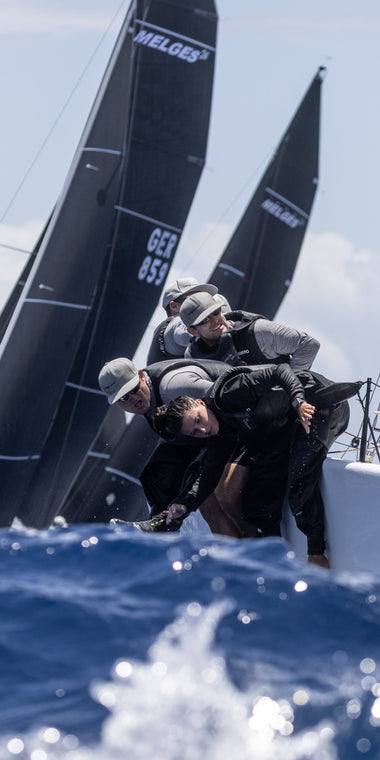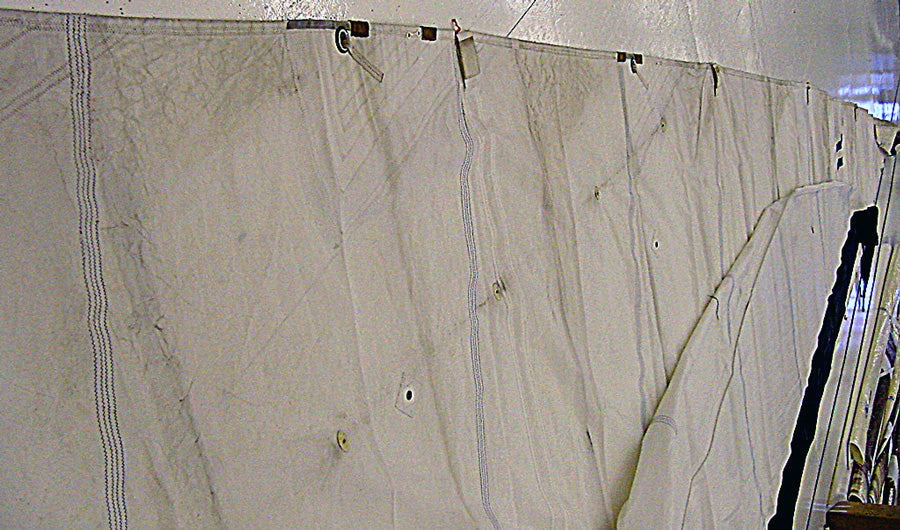MILDEW ON SAILS: WHAT TO DO
MILDEW ON SAILS: WHAT TO DO
Our DIY Sail Care information only applies to traditional fabrics and laminates. 3Di is composite technology, not a sail laminate. For info on 3Di sail care, read Sail Maintenance. Here is what you need to know about mildew on traditional fabrics.
Sails mildew. There are lots of guesses about why some mildew more than others, but not much in the way of facts. Three things we do know:
- Mildew is not a structural problem.
- Mildew is ugly.
- Sail owners get a little uptight when their sails turn black and splotchy.
We can state a few truths about observed patterns regarding sails that have and have not mildewed:
- Sails in hot humid areas are definite candidates.
- It appears to help if the boat owner makes an attempt to keep the sail dry. Take a short sail to air out a damp roller furled genoa, especially if you are leaving the boat for an extended period and your last sailing day involved a lot of rain and salt water spray.
- Salt water residue dries more slowly than fresh water, so salt water dampness is worse than fresh water dampness.
- Areas with higher levels of air pollution, or pollen, tend to have more mildew issues.
- Laminated sails are much more susceptible to mildew than woven Dacron sails.
- Mildew propagates quickly in the adhesive layers of any glued-on parts. Insignia fabric reinforcing and adhesives used to glue together seams are particularly susceptible to mildew growth, because they feature thick layers of glue.
Cleaning Mildew
Sailcloth manufacturers have developed chemical treatments to retard mildew growth when the fabric is produced. However, there is a delicate balance between killing the fungus and killing the humans. So the problem has not gone away.
Surface mildew can be cleaned off the sail with a diluted bleach solution. But once the mildew creeps in between layers of fabric, the sails need to be sent out for industrial cleaning. Wash companies other than sailmakers should be considered suspect. You might get a nice white sail back, but it may also be crumpled up like a bed sheet. For more information, read Should You Wash Your Sails?
In our experience, once a sail has had a mildew problem, it will probably always have a mildew problem. A good cleaner can reduce the black spots to dirty white spots, but if the boat stays in the same area where the mildew started, the spots will soon be gray, and then it’s only a matter of time before they are black again.

How to avoid mildew
- Air out your sails regularly, especially after rain. Try to do this on a calm, dry day.
- Exposure to sunlight is helpful, but too much causes UV Damage.
- Do not put sails away damp or salty. The salt attracts and retains moisture. Store in a dry location.
- If your boat is inactive for more than a week or two, take the sail off the rig and store it dry, or arrange for somebody to air it out periodically.
- Do not install a foam luff on sails prone to mildewing.
If mildew occurs
- Treat mildew at the earliest possible moment. Mildew stains are easier to treat when new, relatively small, and close to the surface.
- Isolate mildew-infected sails from clean sails. A sure way to spread mildew is to rub an existing growth against a receptive surface.
- The most popular mildew remover is household chlorine bleach (sodium hypo chlorite) sold in the U.S. in 5.25% solution. Manufacturers recommend diluting it further. Tilex® and other “mildew removers” are sodium hypo chlorite solutions of about 3%.
- DO NOT use BLEACH on KEVLAR or NYLON, EVER, UNDER ANY CIRCUMSTANCES! We have seen people poke their fingers easily through spinnakers rinsed in chlorine-treated swimming pools.
- DO NOT EVER MIX BLEACH AND AMMONIA! The mixture forms phosgene gas which killed and disabled thousands in the First World War.
- For deep set stains, immerse the stain in a fungicide for 12 hours or more. A high concentration is not necessary. No amount of surface scrubbing will do what a good soak can.
- After using bleach, rinse thoroughly with plenty of fresh water! Bleach residue can cause long-term structural damage.
- If the mildew stain is not removed by above treatments, give up. Further treatments can cause other damage.
- Scotchguard® and related water repellents have not proven to kill or prevent mildew.
- Lysol® household disinfectant is an effective fungicide and inhibitor. Some health and environmental agencies prohibit the use of stronger fungicides.
- Anything you use to kill or remove mildew will wash or wear away in a relatively short time. North NorLam™ fabrics are treated with the most powerful commercial fungicide allowable. It is 100% effective in laboratory conditions, yet demonstrably less effective in the real world.
Lastly, this is what Bill Bergantz, Vice President of North Cloth, has to say about mildew:
It is a poorly kept secret that mildew will grow on sails. While we do not completely understand it and don’t have a lot of good answers for prevention and cure, here is what we do know and what you should know in dealing with the problem of mildew.
- Mildew is a fungus. Like mushrooms (another fungus), it grows best in damp conditions, and probably doesn’t like daylight. It can flourish in climates as diverse as Florida and the midwinter Pacific Northwest.
- Mildew lives on microscopic organisms that it takes from the air, water, or the surface of the sail.
- Mildew will form on modern synthetic sailcloth, including adhesives, finishes, films, etc., but does not cause structural damage.
- Mildew does not affect the performance of sailcloth, so our concern is with the cosmetic disfiguration it can cause.
- Mildew can grow on anchor rodes and mooring lines , sheets and sail covers, dodgers, cockpit cushions, mattresses, bulkheads, and so forth. Mildew spores are carried in the air, especially in rain water, and are easily transferred by contact.



























